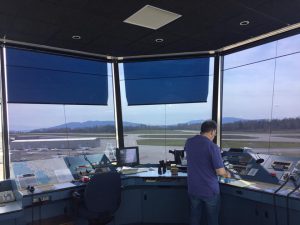
Those Hand Gestures Aren’t Helping
Giving Pilots and ATC A Voice Through Effective Radio Communication
January 2018
I sit across from my wife at dinner leaning forward, eyes fixated on her, and intently nodding at her every word. I can assure you it doesn’t mean I have a clue what she’s been saying for the last five minutes. I might also stare off into space while she’s talking, hearing and receiving everything she’s saying. Two common themes are occurring here: 1) I will get in trouble in either situation and 2) it is a fact that non-verbal communication dominates how we interact. So, what happens when the non-verbal component is removed and we’re left with just our voices? Well, that is what we as pilots and controllers face every day.
I had a controller once tell me that the only way they could direct a multi-thousand-pound aircraft doing several hundred knots was through the tone of their voice. It put the air traffic controller’s job into perspective. Everyone on a given frequency knows when a controller or pilot is having a bad day. Their tone speaks for itself. Good controllers and pilots are able to hide their stress by maintaining a cadence in their transmissions and a calm demeanor. Listen for it next time the radio seems to be a flurry of non-stop chatter. You’ll know it’s working when the pilots adopt the controller’s same demeanor and tone. You’ll also know when that symphony is abruptly ended when a pilot requesting Flight Following isn’t sure of where they are or what they want from ATC.
 So how do those of us that are a bit timid on the radio avoid being the cymbal crasher? It starts with the basics and standard phraseology. No one will chide you for using standard phraseology even if your tone doesn’t command the attention of an auditorium. The AIM is an excellent resource and has a multitude of examples. Listening to others is ideally the next step, but take caution. On a busy frequency some pilots can get away with poorly worded read-backs sprinkled with some jargon that was probably a medieval term from the Scottish Highlands. Hence why you should have a good grasp on what you’ve read in the AIM. While it’s admittedly expensive to rent a plane, and go flying just to hear the chatter on the radio, there are cheaper options. You could purchase a handheld VHF radio to listen in on local frequencies. Better still, go online to websites such as LiveATC.net and pick frequencies from all over the world.
So how do those of us that are a bit timid on the radio avoid being the cymbal crasher? It starts with the basics and standard phraseology. No one will chide you for using standard phraseology even if your tone doesn’t command the attention of an auditorium. The AIM is an excellent resource and has a multitude of examples. Listening to others is ideally the next step, but take caution. On a busy frequency some pilots can get away with poorly worded read-backs sprinkled with some jargon that was probably a medieval term from the Scottish Highlands. Hence why you should have a good grasp on what you’ve read in the AIM. While it’s admittedly expensive to rent a plane, and go flying just to hear the chatter on the radio, there are cheaper options. You could purchase a handheld VHF radio to listen in on local frequencies. Better still, go online to websites such as LiveATC.net and pick frequencies from all over the world.
Sometimes there isn’t an appropriate term or phraseology for a given situation. If such an issue rears its ugly head, just be clear and say what you need. Avoid making your situation worse by remaining vague or disregarding a controller’s instructions. Remember, they can’t see your face and the disappointed look on it when you aren’t getting the assistance you need.
There are a few tips or suggestions that I would like to include that have been passed down to me over the years that I have found consistently worthwhile. These are particularly useful when the frequency is congested with a lot of chatter and/or at busy airports:
Switch to ground after leaving the runway.
This allows you to hear ATC in the event that they need you to move out of the way of an aircraft behind you while you complete your after-landing checks.
Use the word “request”.
If you feel as if your request for Flight Following or practice approaches may take more than a 3-5 second transmission simply state your tail number and “with request” and then wait. This primes the controller so they can anticipate your need for an extra moment. If they reply “standby” remember to be patient and wait. They will get back to you.
Lose the frivolous jargon.
Avoid excessive jargon on busy frequencies. Adding a polite “have a nice day” is cute, but in the words of Kimberly “Sweet Brown” Wilkins, “Ain’t nobody got time for that.” Save those extras for when the frequency is much quieter.
Like any other skill in aviation, radio communication takes practice. The key is keeping it concise and to-the-point. Find a friend or instructor to practice with and make efforts to visit airports with operating control towers regularly to keep current. Many control towers even offer tours. Having the “ground knowledge” of radio communications can greatly improve your non-non-verbal communication skills!